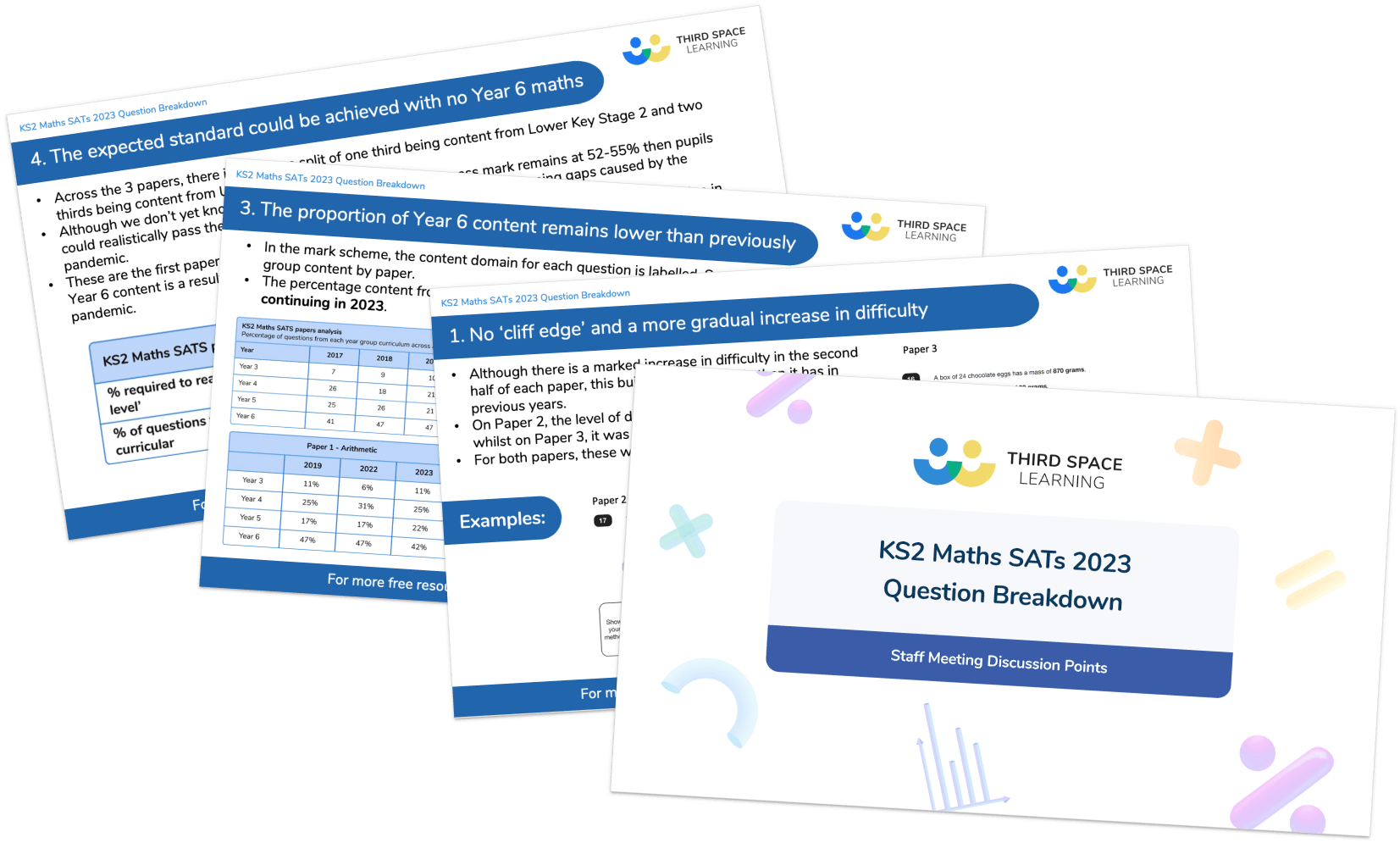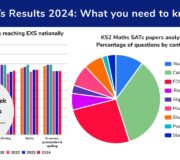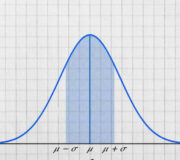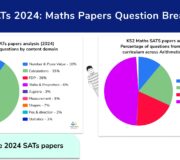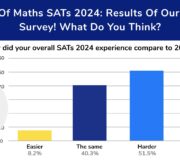SATs Results 2023: Headlines And Next Steps For Senior Leaders
This page was updated with all the results, SATs data and analysis on Tuesday 11th July 2023, including commentary from our expert author, Emma Johnson.
After considerable controversy over the level of difficulty of this year’s test papers and a week later than originally scheduled, the national SATs results 2023 are finally in.
Before we start, it’s worth remembering that Covid first struck when this year group was halfway through Year 3. With this in mind, the big question is how are things looking for this cohort of students? Is the disruption to pupils’ first two years of KS2 still having an impact on attainment? On another note, will this year’s reading results be affected by the level of difficulty of the 2023 paper?
In this article, we delve into the answers to these questions and provide a comprehensive analysis of this year’s results with a focus on Maths Arithmetic & Reasoning. We’ll also be discussing what these results mean for your school and offer guidance on the best course of action moving forward.
SATS 2024: STAY UP TO DATE
Join our email list to stay up to date with the latest news and free resources for SATs 2024. As usual our expert teachers will be on hand to provide one to one tuition support, revision resources, expert analysis on papers and the 2024 SATs results.
- National attainment is broadly consistent with 2022
- National attainment remains considerably below the pre-pandemic levels of 2019
- What were the raw and scaled scores for SATs 2023?
- A drop in attainment for both maths and reading
- SATs 2023 maths paper analysis: how did content domains relate to marks?
- KS2 SATs results 2023: the next steps for your school
- How can Third Space Learning improve SATs results in maths?
National attainment is broadly consistent with 2022
Let’s begin by taking a look at the national picture for SATs 2023:
- 59%* of pupils reached the expected standard in all of reading, writing and maths, unchanged from 2022
- 73% of pupils met the expected standard in reading, down from 75% in 2022
- 73% of pupils met the expected standard in maths, up from 71% in 2022
- 71% of pupils met the expected standard in writing, up from 69% in 2022
- 72% of pupils met the expected standard in English grammar, punctuation and spelling, unchanged from 2022
*This figure was later updated to 60% with more recent data after remarks
At first glance, the national attainment for the 2023 Key Stage 2 SATs is broadly similar to that of 2022. The percentage of pupils achieving the expected level across the three subjects of reading, writing and maths has remained unchanged at 59%.
The percentage of pupils achieving the expected standard in both maths and writing has increased by 2%, whilst there has been a 2% fall in the percentage of pupils achieving the expected standard in reading.
Later in this article, we will delve a little more into these results by taking a closer look at the raw scores and corresponding scaled scores for each subject. Looking at these, it is clear that a higher national attainment percentage doesn’t necessarily mean that this cohort of students has reached a higher level of attainment than the students in 2022.
To be able to analyse the continued impact of the Covid pandemic, we need to take a look at the longer-term picture, to ascertain how the results achieved by the pupils in 2023 compared to those achieved by pupils prior to 2020.
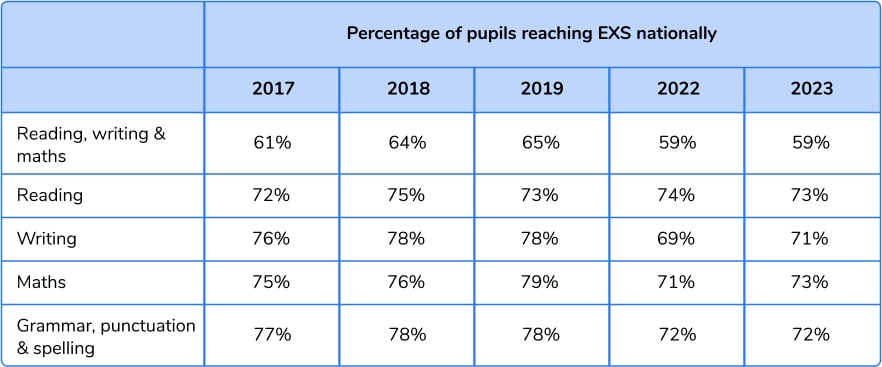
(Attainment in writing is not directly comparable to 2017 because of changes to writing teacher assessment frameworks in 2018)
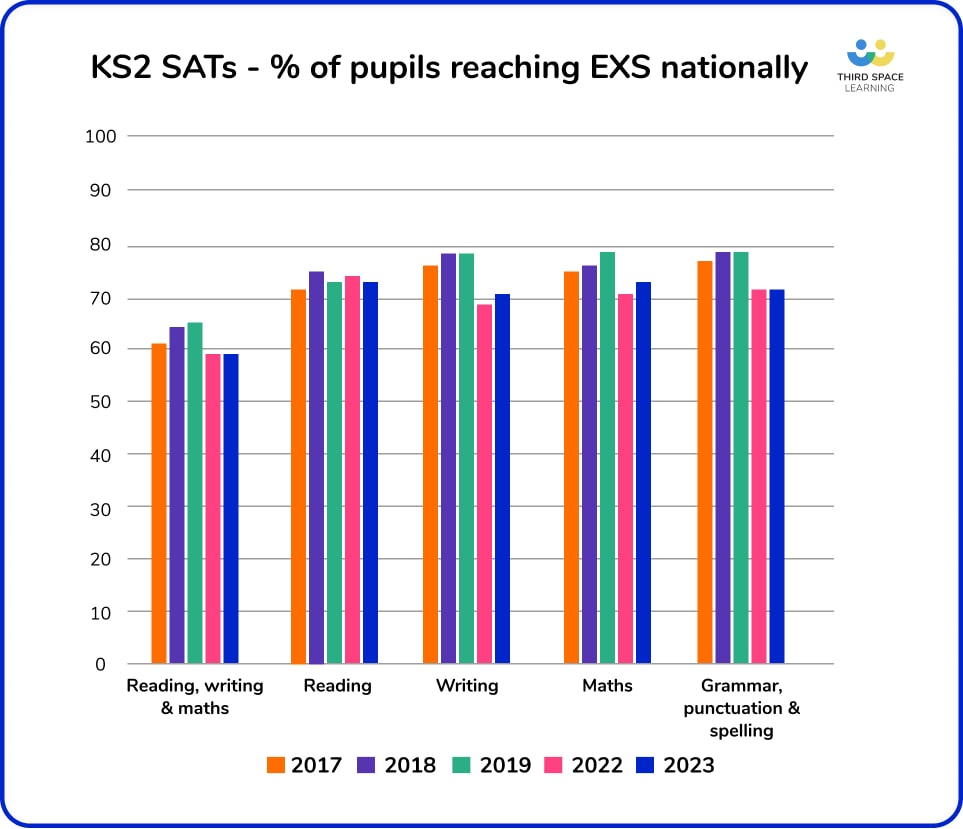
Maths SATs 2023 Question Breakdown: Staff Discussion Points
See the 15 lessons you should take from our question-level analysis of the KS2 SATs 2023 maths papers. Great for staff meetings.
Download Free Now!National attainment remains considerably below the pre-pandemic levels of 2019
While standards improved in the years leading up to the Covid pandemic, there was a noticeable drop in the overall attainment in reading, writing and maths. The percentage of pupils achieving the expected standard in 2023 remains 6% lower than the percentage achieving this standard in 2019.
With the Department for Education’s announcement last year of a ‘Levelling Up mission’ for 90% of pupils to meet the expected national standard in reading, writing and maths at the end of primary school by 2030, there is clearly a considerable amount of work needed to achieve this mission.
In the three years prior to the Covid pandemic, the trend in maths, writing and GPS showed an increase in the percentage of pupils reaching the expected standard. However, reading percentages have been less consistent (fluctuating between 72% and 75%).
This fluctuation has continued with last year’s increase in percentage to 74% dropping back down to 73% in 2023. The question here is whether this fluctuation is down to an inconsistency in the level of difficulty each year, rather than a fluctuation in the ability of the pupils.
Reading SATs scores, unlike other subjects, seems to have been least negatively impacted from the school closures. In 2020, 73% of pupils achieved the expected standard, which is consistent with the percentage achieved in 2019 and surpasses 2017 by 1%. However, the same can’t be said for maths, writing and GPS which have all suffered considerably. Maths performance remains 6% below the level reached in 2019, whilst writing and GPS are still 7% and 6% below.
What were the raw and scaled scores for SATs 2023?
Pupils’ raw scores for each paper are converted to a standardised score, with a score of 100 required for a pupil to be considered to have reached the expected standard (EXS). A child achieving a standardised score of 110 or higher is considered to be working at greater depth, or ‘meeting the higher standard’.
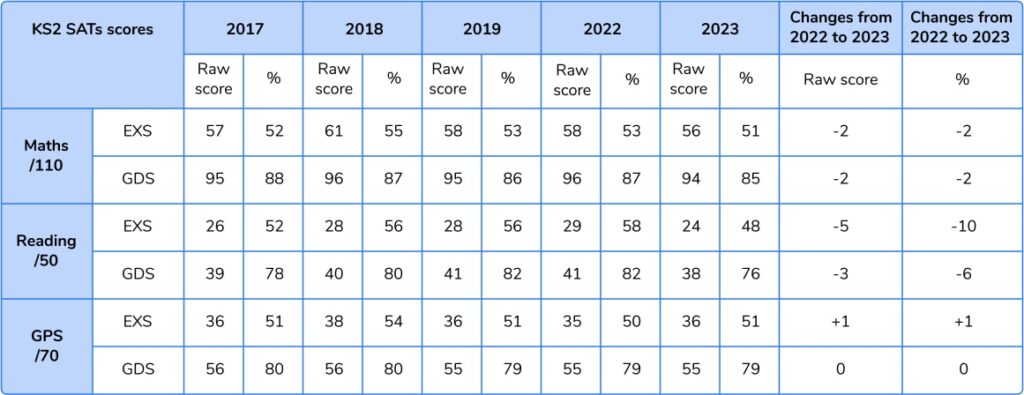
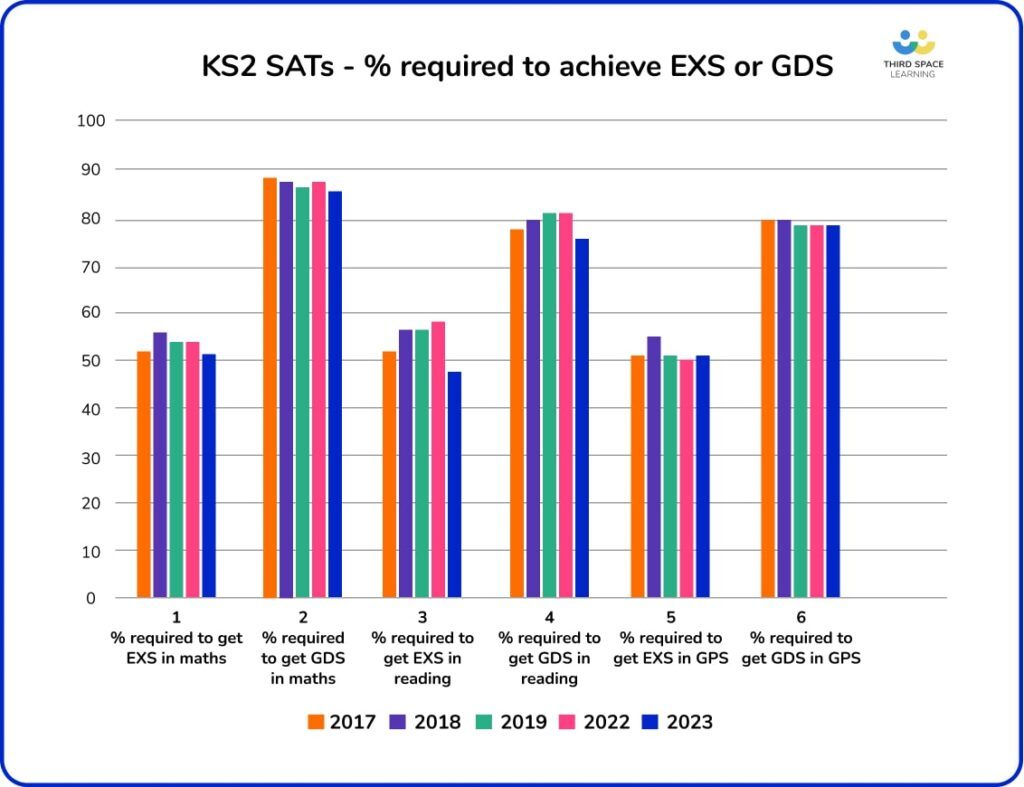
A drop in attainment for both maths and reading
A drop in the raw score required to reach the expected level in the reading paper probably hasn’t come as a surprise to many. Following the widely publicised level of difficulty of the paper, the pass mark was generally expected to drop.
The raw score dropped considerably not only for reading but also for maths, despite the paper containing less Year 6 content than previous years (only 36%). This strongly suggests that the level of difficulty of the papers is not the only factor at play here. School closures during the Covid pandemic have clearly continued to impact this cohort of pupils.
The raw scores to achieve both EXS and GDS in maths are the lowest ever, with 56/110 (51%) being a drop of 2% compared to the score needed in 2022 and a drop of 4% compared to the score needed for the 2018 papers. This year, a raw score of 94 (85%) was needed to achieve GDS, also a 3% decrease compared to the score required in 2022 and 3% lower than the highest score needed over the past 5 years (in 2017).
In the SATs reading paper, the fall in attainment is even more dramatic, with a drop in the pass mark for achieving EXS from 29/50 (58%) in 2022 to this year’s mark of 24/50 (48%). There was a huge 10% drop in the mark needed to reach EXS and a 3 mark drop to reach GDS, from 41/50 (82%) in 2022 to 38/50 (76%) this year.
The GPS paper is the only paper not to have followed this trend for a fall in attainment, with the raw score needed to achieve the expected level increasing by 1 mark to the pre-pandemic level of 36/70 (51%), compared to last year’s score of 35/70 (50%).
While not a significant increase for the GPS paper, the question here is, why has attainment fallen so considerably in maths and reading, but has remained consistent with pre-pandemic levels for GPS? How much is this down to the difficulty of the paper and how much is down to the impact of Covid? Considering last year’s reading actually showed a rise in attainment, then questions do certainly need to be asked regarding how appropriate this year’s reading paper actually was.
Little change in average scaled scores
The average scaled scores show the mean scaled score for all pupils (from 80 to 120). These scores show us the typical performance of all students taking the tests, taking into account the performance of pupils across the full range of scores. The percentage of pupils achieving the expected standard only takes into account the pupils working at or above a scaled score of 100.

On the surface, the average scaled scores appear to have changed very little over the past 5 years. Reading scores were higher in both 2022 and 2023 than they were before the pandemic and maths scaled scores were 1 point below but in line with scores achieved in 2017 and 2019. GPS came out at 1 point lower than pre-pandemic scores.
Looking more closely at the conversion tables that show how the raw scores match the scaled scores each year, it is clear that these vary considerably from year to year. Children across the full range of scores needed to score less for the average scaled score to remain the same.
If we take the controversial 2023 reading test, for example, the lowest scaled score which could be achieved in the paper was 82 for a pupil with a raw score of 3 marks. This compares to 2022 when a pupil scoring 3 or 4 marks would only achieve a scaled score of 80. This continues throughout, with a raw score of 20 in 2023 being given a scaled score of 97, whilst 20 in 2022 would have received a scaled score of 93.
This variation in scaled scores does seem to imply that the DfE has tried to ensure a higher percentage of pupils have achieved both the expected and higher standard in the reading paper in particular and, again, raises the question of how appropriate this paper was for assessing this cohort of pupils.
SATs 2023 maths paper analysis: how did content domains relate to marks?
Highest percentage of content from Year 3 to Year 5 and lowest ever pass mark

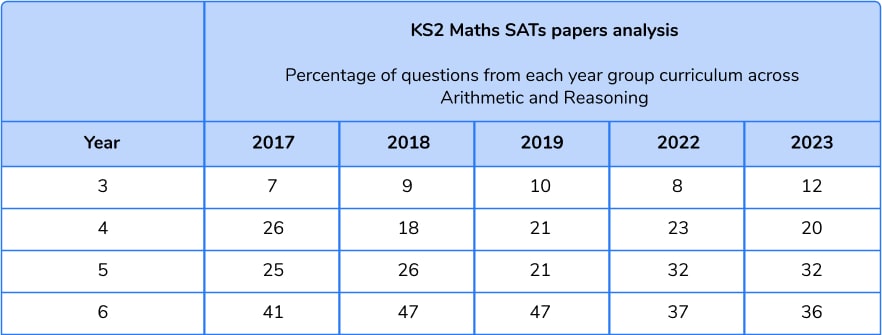
The 2023 paper had the highest number of marks from content from the Year 3 to Year 5 curriculum than any paper in the past 5 years. This, coupled with the lower percentage required to pass does suggest that attainment in maths is lower than the headline figures would suggest.
The possibility of passing the test without any knowledge of the Year 6 curriculum was clearly higher in 2023 than it has been in any of the years previously. This year, the pass mark was 51%, with 64% of the paper being from Years 3 to 5. If we look back to 2019, the pass mark was 53%, with 52% of content being from Year 3 to 5.
Children could have reached the expected standard in the 2023 SATS by focusing on just two content domains
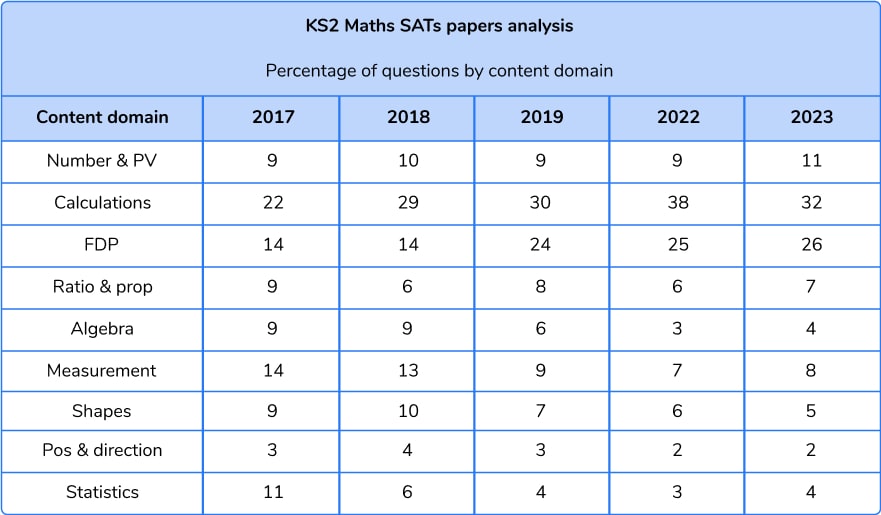
As with previous years, the two most content-heavy domains were calculations and fractions, decimals & percentages (FDP). With these 2 areas accounting for 58% of the total marks and the pass mark being 51%, pupils could have comfortably reached the expected standard by focusing solely on these two domains.
The SATs arithmetic test is still the key to achieving good maths results
Of the three maths papers, the arithmetic paper is the easiest to prepare the children for. There are also far fewer surprises in this paper, compared to the two reasoning papers. As a result, children generally achieve higher scores in this paper.
This year, only 56 marks were required across the 3 papers for pupils to achieve the expected standard. With this in mind, if children were to achieve a score of 30 out of 40 in the arithmetic paper, they then only needed a total of 26 marks (37%) across the 2 reasoning papers to be considered as having reached the expected standard.
KS2 SATs results 2023: the next steps for your school
It’s likely that there are many things school leaders and teachers will want to do with the KS2 2023 SATs results, including:
- Compare your school performance to national data
- Check whether papers need remarking
- Identify areas of strength and weakness
- Predict progress scores
- Report the KS2 2023 SATs results to children and parents
- Support staff
- Consider your Year 6 cohort
- Celebrate your KS2 2023 SATs results
For more information and advice for carrying out each of the eight steps above, take a look at SATs results 2024.
How can Third Space Learning improve SATs results in maths?
Our SATs revision programme has supported thousands of Year 6 pupils over the years, providing targeted revision that combines a focus on the individual’s gaps with the key topics they need to know for the SATs exams. Every year, our Curriculum Team reviews the SATs papers to identify those high-impact topics and embed these learnings into the programme.
Our SATs revision lessons have been designed around a maths mastery approach building fluency, reasoning and problem-solving.
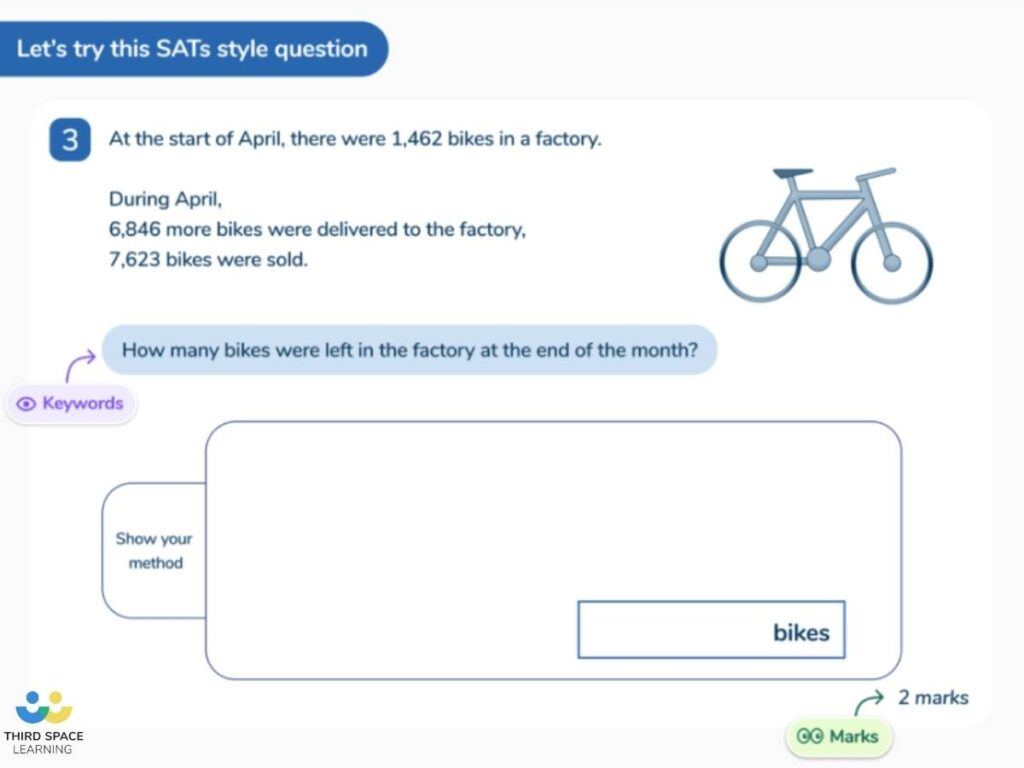
Schools often use Third Space Learning to support their target pupils who would otherwise not be securely on track to achieve the expected standard. With the support of our one-to-one tutors, most of them are able to turn around their SATs results.
We sent out a post-SATs survey to our wonderful community of schools to hear about how Third Space Learning’s revision programme supported their Year 6 pupils this year. Here’s what they had to say:
- In their 2023 SATs results, Third Space Learners were more likely to achieve higher scores in their maths SATs than the rest of their cohort and than the national average
- 100% of teachers agreed that weekly one to one sessions with their tutors helped their Third Space Learners to achieve a higher score than they otherwise would have – with the majority saying they ‘helped significantly’
- 100% of teachers agreed that Third Space Learning has had a positive impact on their Year 6 pupils’ overall engagement and confidence in maths



Read more about SATs results:
- SATs Results 2022: What You Need To Know
- KS2 SATs Results 2018: Next Steps For Your School
- KS2 SATs Results 2017: What To Do Next
- KS2 SATs Results 2016 Are In… What Next?
- How Hague Primary Took Pupils From Single-Digit Scores To Reaching Expected Standards In Their 2022 Maths SATs
- What Are SATs?: A Comprehensive Guide
DO YOU HAVE PUPILS WHO NEED MORE SUPPORT IN MATHS?
Every week Third Space Learning’s specialist primary maths tutors support thousands of students across hundreds of schools with weekly online 1 to 1 maths lessons designed to plug gaps and boost progress.
Since 2013 these personalised one to one lessons have helped over 150,000 primary and secondary students become more confident, able mathematicians.
Learn about the SATs revision programme or request a personalised quote for your school to speak to us about your school’s needs and how we can help.

